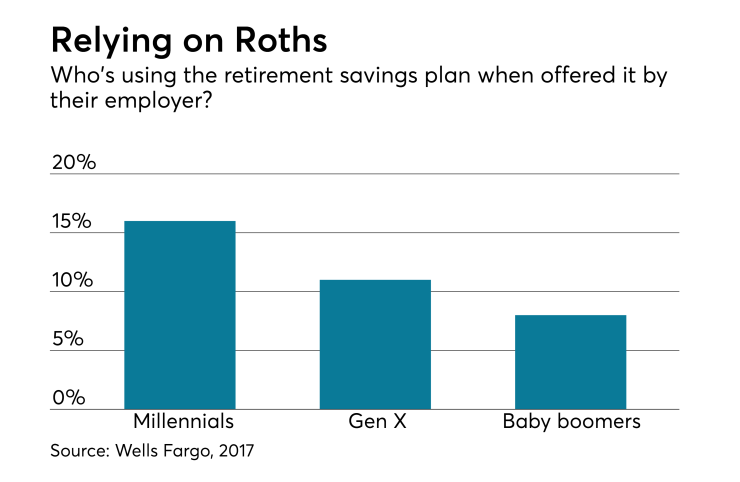More than 70% of defined contribution plans offered the ability to make Roth contributions in 2017, up from about 50% in 2010, according to Callan. As with IRAs, Roth 401(k)s provide savers the opportunity to decide if they want to pay taxes on their savings now or in retirement. Traditional plan contributions are made on a pre-tax basis, and withdrawals in retirement are taxed as income. Roth contributions are made on an after-tax basis, so retiree withdrawals are not taxable.
There are merits to making contributions on both pre-tax and after-tax terms, but the major factors in determining which path to take will likely change throughout participants’ careers and as their expectations for the future evolve. Having both tools at their disposal helps employees optimize their retirement planning efforts over time.
There could be potential drawbacks, however, to offering Roth contributions in defined contribution plans. The Center for Retirement Research argues that participants transitioning to Roth contributions will likely either seek to maintain the size of their contributions — meaning they would see their tax bills increase today — or they’ll decrease their contributions to offset the tax implications.

Participants that maintain their contributions (and face a larger tax bill) would be better off in retirement since — all else equal — they’d have the same nest egg as a comparable saver with a traditional 401(k), but their withdrawals would be tax free. But plan sponsors and benefit advisers should understand the communication challenge inherent in offering participants the ability to make Roth contributions.
Pre-tax or after-tax? That is the question
The key determinant in whether a participant should prefer Roth contributions over traditional pre-tax contributions boils down to whether their taxable income is expected to be higher now or when they make withdrawals in retirement. If their taxable income is going to be higher in retirement, then it’s sensible to pay taxes on contributions now and avoid them in retirement. Younger employees — earlier in their careers and thus lower on the compensation spectrum — are more likely to fall into this scenario, and so Roth contributions will arguably have greater appeal to younger workforce demographics.
Plan sponsors would do well to help guide participants through the decision-making process to improve outcomes. Sponsors are not tax professionals, and shouldn’t attempt to provide personalized tax advice, but explaining the important factors in determining which types of retirement plan contributions to consider can significantly help improve participant success. Pointing participants to useful resources on the subject can also go a long way.
A match — but not necessarily made in heaven
Let’s say a participant decides to make the switch to Roth contributions. The employer can continue to match those contributions, up to its limit. Business as usual, right?
Not so fast. Employers cannot make after-tax matching contributions on behalf of participants. Any match remains pre-tax, even if participants are making after-tax Roth contributions. This adds an unavoidable layer of complexity to a participant’s decision whether to contribute on a pre-tax or after-tax basis. Crunching the retirement-saving numbers will not be as straightforward.
But it’s not insurmountable by any stretch. Plenty of retirement savers are familiar with this dynamic in their IRAs, and it doesn’t ultimately disadvantage participants.
The availability of a Roth option means they’re still able to save their contributions toward tax-free income in retirement, even if matching contributions will be taxable.
Depending on whether plans allow for it, participants can periodically convert pretax 401(k) assets into their Roth 401(k) (called an in-plan Roth conversions), much like the option available to IRA savers. Only a small percentage of plans actually offer this feature, primarily because it is very seldom used.
Evidence suggests there’s a deep need for thoughtful communication about these admittedly complicated aspects of Roth contributions: The Plan Sponsor Council of America found that only about 18% of participants with access to Roth contributions took the opportunity to make them in 2016. Roth contributions can help participants prepare more effectively for their retirement, and it’s worth making sure they know it.




